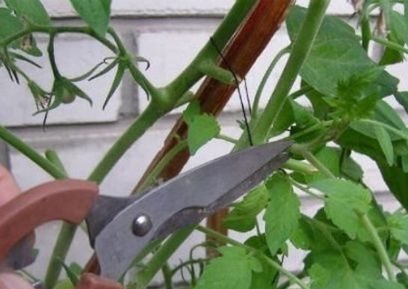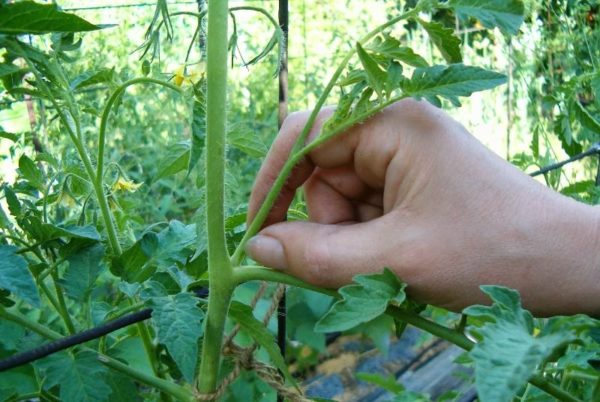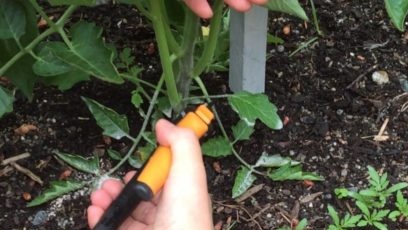Controversial once Tomato leaf removal procedure, has long been proven to be effective. Agricultural scientists confirm that the correct thinning of the leaf apparatus helps to achieve several goals at the same time: reduce the risk of morbidity, increase yield, and reduce ripening time.
Removal Effect

Neat tomato bushes tend to grow rapidly as they grow. This applies to tall subspecies and determinant varieties. A large vegetative mass is responsible for an important chemical process, photosynthesis. But the goal of vegetable growers is not lush bushes, but a bountiful harvest. Therefore, it is important to intervene in the natural process in time to remove excess vegetation. The procedure is necessary for greenhouse representatives and for tomatoes growing in the open.
As a result of a correctly conducted procedure, several positive aspects are simultaneously achieved:
- improved air exchange. In adult tomatoes, shoots are quite voluminous. Therefore, even if the scheme is followed, oxygen access is impaired. Weak air exchange leads to increased air humidity. This is especially dangerous in the greenhouse. A humid microclimate is optimal for the development and spread of pathogenic bacteria. The lack of fresh air allows bacteria to enter the plants and cause their disease;
- preservation of moisture and nutrients. The leaves of an adult plant are quite large. From a large surface area, a lot of moisture evaporates. In addition, leaf plates draw nutrients and vitality from tomatoes. After removal, all the energy goes to the formation and filling of the fruits;
- contact with soil is excluded. As the bushes grow, leaf plates reach a length of 20-25 cm and hang limply to the ground. In the soil live not only beneficial microorganisms, but also pathogenic bacteria. On foliage, they easily move to healthy plants and affect them;
- providing enough light. Tomatoes are very sensitive to low light. Sunlight is essential for the production of sugars during photosynthesis. The more sugars produced, the greater the ability of plants to form fruits. The less bushes obscure each other, the more sugars are produced.
What leaves to remove
 Sometimes the first time you have to pick off the leaves directly when transplanting seedlings to a permanent place. When planting thin, elongated seedlings, agricultural technicians recommend digging the stem into the soil. In this case, a pair of lower leaves of the tomato is already worthless. They only rot in the earth and become a source of the spread of disease.
Sometimes the first time you have to pick off the leaves directly when transplanting seedlings to a permanent place. When planting thin, elongated seedlings, agricultural technicians recommend digging the stem into the soil. In this case, a pair of lower leaves of the tomato is already worthless. They only rot in the earth and become a source of the spread of disease.
In stocky seedlings planted in the usual way, the lower foliage can be removed after 2-3 weeks from the transplant. By this time, the bushes will get used to the new conditions. Therefore, the procedure will not cause them stress. The appearance of sheet plates, as a rule, itself speaks of a loss of functionality. Lacking limp, wilted, often yellowed and touching the soil shoots - the first contenders for pruning.
To determine that the time has come to thin out the bushes is possible in appearance. Trimming the leaves:
- creating a shadow to the fruits on the plant, neighboring bushes;
- lapped with the foliage of nearby bushes;
- located under the fruit brush, on which all the fruits have already formed;
- located in the surface of the plant;
- fattening branches (not forming fruits).
In addition, be sure to immediately remove leaves with signs of illness, shoots with mechanical damage and dried parts of the plant.
Rules for

In order to properly remove the leaves, you need to prepare the following:
- scissors or pruners (well sharpened);
- a bag or bucket for plant debris;
- gloves
- aqueous solution of potassium permanganate.
 You may be interested in:
You may be interested in:Although removing leaf blades is beneficial, it is stressful for plants. Therefore, it is necessary to carefully and painlessly carry out the procedure. Agricultural technicians recommend not cutting off the leaves with their hands, but cutting them off with a tool. Then the slices will be even, which means they will heal better. After processing each bush, the tool should be decontaminated. In this case, the infection is not transferred from one bush to another. Begin with the lower vegetation. Then you can go to the shoots located on the north side. It is important to remember that you cannot remove more than three leaves at a time.
Do not neglect the procedure of pruning leaves. It does not take much time and effort. Such a simple agricultural technique will help to grow a rich tomato crop. The main thing is to comply with all the rules and recommendations and not harm the plant.




 Low-growing tomatoes, without pinching: 5 of the most delicious varieties
Low-growing tomatoes, without pinching: 5 of the most delicious varieties Why tomato seedlings grow poorly
Why tomato seedlings grow poorly We grow a tomato in a shell
We grow a tomato in a shell Growing tomatoes without watering according to the method of Kazarin
Growing tomatoes without watering according to the method of Kazarin
Hello, I’m a gardener with an experience of 30 years. But I can’t grow tomatoes. I feed and pinch, but very few tomatoes. I sit in a greenhouse, along with them grow cucumbers, peppers, eggplants. They say that you can’t plant together, tell me please.